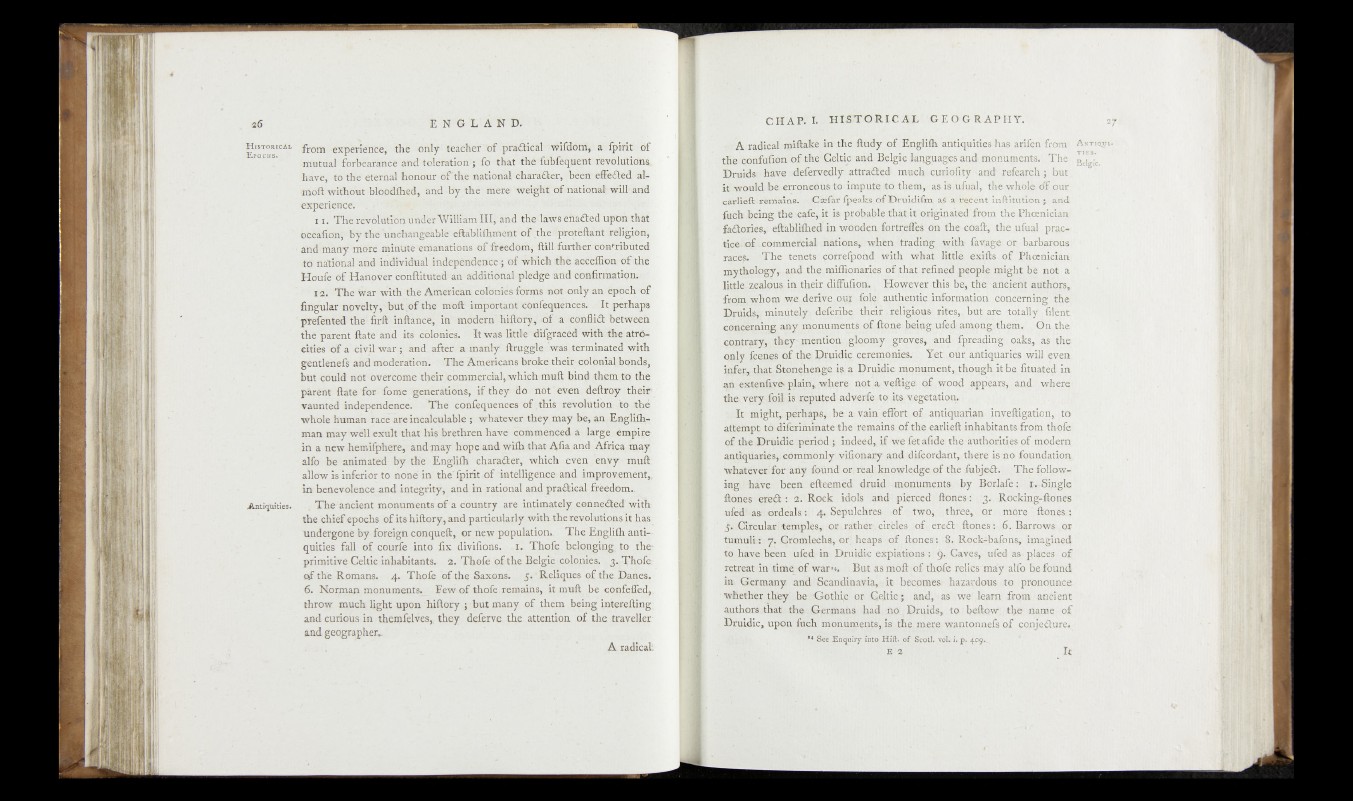
WffiISTORTCAL
PQGHS. 4. •
AstKjraties.
from experience, thé -only- te a ch e r's# pradtócal' vwifdotn,-
mutual forbearance afcd'fölèpfctiom; fb that «thé Yu'bföqjaept- hfevokations,
•have, to the éterpal honour öf^the national charaéfcer, b.eemd&(3:ed al-
ifiioft without blood-fhed, and -by the mere weight o f national*- will -and
experience. *
11. Tbhrëvólötïörihinder William III, 3tnd the- lawS^e^^betTupOii th a t
occaficfn', b y th ë h'nchangekble -eftablifbment o f the^proteftant religion,
and many more mintfte emanations of freedom, ftill further contributed
■to national and individual independence-; s f which $hè aecef&on -of .the
Houfe of Hanover conftituted an additional-'.pledge and ctm&rmation.
] 2. The war with the American. cpfönMs "forms not only ran h ^ p eh /o f
fingular novelty, 'b u t o f th e moft important tphleqriehces. It perhaps
prefented the • firft inftincfej ift modern" hiftory, »of .a coaflidt between
th e parent ftate and its ,colonies. ‘ It was littVe^diTgraced'with .the atrocities
o f a" civil wan; and after a manlyfftnuggl©-’was terminated vfith
gentlenefs and moderation. The tSmericans brbke theitjcölQnialfbqnds,
but could not'overcome their -commercial, .whichumift hin^jjshem to. th e
parent ftate for fóme generations, if they Bo aïöt * even deftrqy * theifr
vaunted independence. T h e confequences h f , this ‘ rèvolütiöp.- gfrpitbé
whole human face are incalculable ; whatever they may be, amE^^g’liih-
tnan may well exult that his brethren have commeheed.-a large empire
in a new hemifphere, andpoay hope and wiJh that Afisand-Africa-may
alfb be animated by the Engliftf charaQer, which - even envyj?rtiwift'
allow is inferior to n d n p in the' fpirit,o f ■'intelligence- and improvement*
in benevolence a n d integrity, and in rational and pradkical freedom..
, T h e ancient monuments o f a country .are intimately connedled wirtr
the chief epochs o f its hiftory, and particularly w ith the revolutions it has
undergone by foreign conqueft, or new population*.. T h e EngliCh antiquities
fall o f courfe into fix divifions. -4. Thofe belonging to „thp-
primitive Celtic inhabitants. 2. Thole of the Belgie colonies. 3. Thofe:
a f the Romans. 4» Thole of the Saxons. 5. “ Reliques ©jf the, Danes.
6. Nonnan monuments. Few o f thofe remains, it mttft he confeffed,
throw much light upon hiftory ; b u t many of them .being intefefting.
and curious in themfelves, they deferve th e attention of the. traveller:
and geographer*
A radical!
• A radical miftakellpSjthe I tu d y o f Englilh antiquities has arifen from1
the oonfufiran of the1 Celtic'and Relate ;Jaftgudg^f'4tqd. Monuments.' The
Draidso have jrdef^EV'etSy attracted m'Uc^if^'^fity'iajacl' f&fe^rqh ; but.
it would be erroneous to impute to them, as is*ufual, the whole o'f our
carlieft .remains. ;v Cifefar' fpeahs: bfiDiruidifn^ a£ ari^pent in h ib itio n ; and
fiicb.iyings the;ca£eyM$ .pjol^bl'e.that'iti' G^iginajedf from the,Phoenician
fadkories,. eftaffliftied in TyOpdetir fprtrblTes pn rth© coaft, the ufual prap-
treeuof,.c om m ie ife ia l< i0®s^1 jwhbn trading wijh) on. barbarous '
ra'ces. | | l h e tenhtsqeorrilpbrul-»ith v?Lat lm?lei(<''exi‘fts o f '||hoeijdcidii|
mythology,-,.and t b e j i |^ o ;n ^ ^ ^ ^ a t f e h ^ ^ ^ q o p l p .m 'i g |^ |i , .'n O t a
litdefzealpus in their diffiffipm^ However> this- be, 'the1 ancient authors,,
from, w hom we dert|feiqui\ fata authentic informatianycob^rding/the
Dr-uids:» minjj fcdjyj. &!}, W© li.le.nt,
caneefning any monmne^ts pftftcine tom g jn& d ^ ^ e n g ^ th e p u 't 0 n ,ih e i
contrary, th e y .mention, „g^qtany groves, and Xj^ejdnj'g oaks, ijistjthe
qo|y ft sues o f .the.Druidic cqremoniesy < Yiedupar^-antiqijiari^fwill even,
mfer^thah&pnfhenge is aiDru^dic, monument,(though it bq fituated in,
an< ext»enftve> plain*, w§here nqt »a veftige o f woqd appears, ■ and where
the< very4jEgih,is rjeputed tsdvefff©;tq its-wegetaticaij.[ ,
■;. It might,-perhaps, be a, vain effort, oh- ahti^jia’riah jinye’^gation^ to
attempt tadiferiminate the •remains..of the earlieftinhabitanssi^nhi'thofe.
of the Druidic period ; „indeed, if we Ipt dfid^ the • authpriri<js. a f iripdern
antiquaries, cOfnnaonly vihonary an d di-fcordant,thqie is;no. foundariotr
whatever "for any found! or; real knowledge, p f the f\ibj.e<ft.; .The fpliow-
ing.t;hive been fefteemed druid »monuments by Borlafe; 1 -Single
ftanes' eareift: 2. Rock idol» .and pierced fto n e s-^ p . Rockihg*ftdnhs
iafed*>asf? or.deala :1 4, Sepulchre»^ o f;^-t\ytb„ „three,s’o.r more ' ftones,:
^iuGireular,tamples, ©r■ r a th e r .c it ie s , of5 e’Cefl:• .ftones: 6. Barrows,os
tum u li: 7. Cromlechs* or heaps' of ftones : 8. Rock-bafons, imagined
to have been ufed in Druidic expiations: 9. Caves, ufed as -places o f
retreat in time o f war>*. . But as moft of thofe relics may alfo be found
in, Germany and Scandinavia, it, becomes, hazardous to pronounce
' whether they be -Gothic or .Celtic; and, as we learn from' ancient
^ithprsithas-. th© 0ht5m%h$>ihadcppi D r u i d s ^ , ' t h d 11
Druidic, upon Inch monuments,, is the mere wantonnefs o f conjecture.
See Enquiry into Hift. o f Scot!, vol.- i. p. 409^.
e 2 > It
A u T i^ t
T%S. " -
Be%ic*